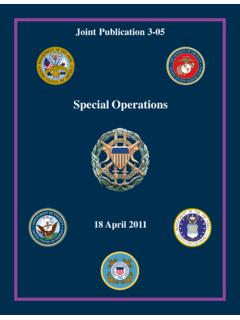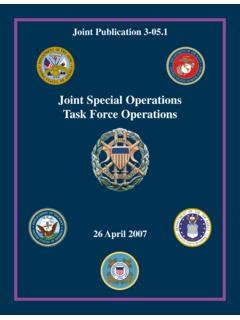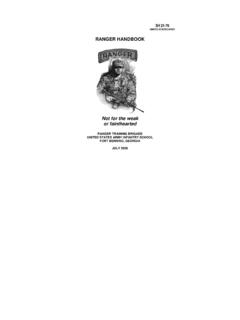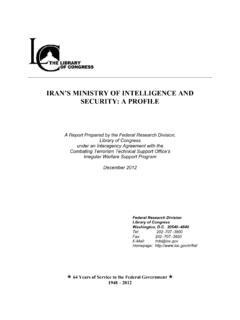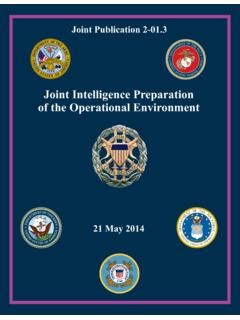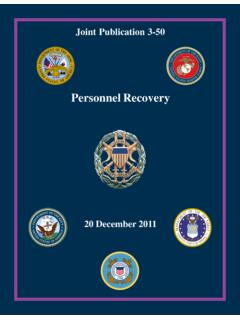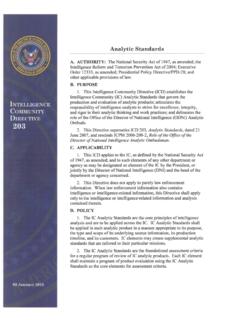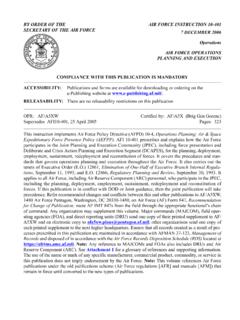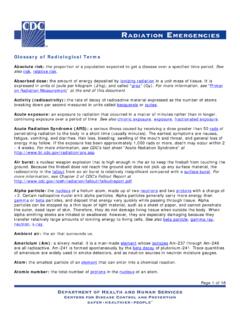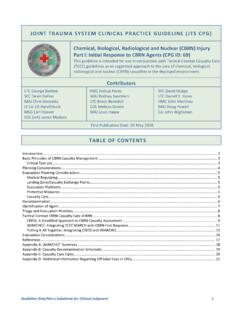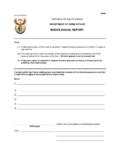Transcription of Unmanned Systems Integrated Roadmap FY2011-2036
1 Unmanned Systems Integrated Roadmap FY2011-2036 i 3 DRAFT This document is predecisional. This document is pre-decisional. Approved for Open Publication Reference Number: 11-S-3613 Unmanned Systems Integrated Roadmap FY2011-2036 ii Intentionally left blank Unmanned Systems Integrated Roadmap FY2011-2036 iv Intentionally left blank Unmanned Systems Integrated Roadmap FY2011-2036 v EXECUTIVE SUMMARY and allied combat operations continue to highlight the value of Unmanned Systems in the modern combat environment. Combatant Commanders (CCDRs) and warfighters value the inherent features of Unmanned Systems , especially their persistence, versatility, and reduced risk to human life. The military Services are fielding these Systems in rapidly increasing numbers across all domains: air, ground, and maritime.
2 Unmanned Systems provide diverse capabilities to the joint commander to conduct operations across the range of military operations: environmental sensing and battlespace awareness; chemical, biological, radiological , and nuclear (CBRN) detection; counter-improvised explosive device (C-IED) capabilities; port security; precision targeting; and precision strike. Furthermore, the capabilities provided by these Unmanned Systems continue to expand. The Department of Defense (DoD) has been successful in rapidly developing and fielding Unmanned Systems . DoD will continue to focus on responding rapidly to CCDR requirements, while ensuring Systems are acquired within the framework of DoD s new wide-ranging Efficiencies Initiatives1 . In the fiscal environment facing the Nation, DoD, in concert with industry, must pursue investments and business practices that drive down life-cycle costs for Unmanned Systems .
3 Affordability will be treated as a key performance parameter (KPP) equal to, if not more important than, schedule and technical performance. DoD will partner with industry to continue to invest in Unmanned Systems technologies while providing incentives for industry to implement cost-saving measures and rewarding industry members that routinely demonstrate exemplary performance. This document provides a DoD vision for the continuing development, fielding, and employment of Unmanned Systems technologies. Since publication of the last DoD Roadmap in 2009, the military Services have released individual Service roadmaps or related strategy documents. This Roadmap defines a common vision, establishes the current state of Unmanned Systems in today s force, and outlines a strategy for the common challenges that must be addressed to achieve the shared vision.
4 The challenges facing all military Services in the Department include: 1) Interoperability: To achieve the full potential of Unmanned Systems , these Systems must operate seamlessly across the domains of air, ground, and maritime and also operate 1 Better Buying Power, Guidance for Obtaining Greater Efficiency and Productivity in Defense Spending, OUSD(AT&L) Memo, Dr. Ashton B. Carter, 14 September 2010. My Acquisition Decision Memorandum (ADM) approving formal program commencement of the program will contain an affordability target to be treated by the Program Manager like a Key Performance Parameter (KPP) such as speed, power, or data rate .. Under Secretary of Defense Memorandum for Acquisition Professionals, Better Buying Power, September 20101 Unmanned Systems Integrated Roadmap FY2011-2036 vi seamlessly with manned Systems .
5 Robust implementation of interoperability tenets will contribute to this goal while also offering the potential for significant life-cycle cost savings. 2) Autonomy: Today s iteration of Unmanned Systems involves a high degree of human interaction. DoD must continue to pursue technologies and policies that introduce a higher degree of autonomy to reduce the manpower burden and reliance on full-time high-speed communications links while also reducing decision loop cycle time. The introduction of increased Unmanned system autonomy must be mindful of affordability, operational utilities, technological developments, policy, public opinion, and their associated constraints. 3) Airspace Integration (AI): DoD must continue to work with the Federal Aviation Administration (FAA) to ensure Unmanned aircraft Systems (UAS) have routine access to the appropriate airspace needed within the National Airspace System ( NAS) to meet training and operations requirements.
6 Similar efforts must be leveraged for usage of international airspace. 4) Communications: Unmanned Systems rely on communications for command and control (C2) and dissemination of information. DoD must continue to address frequency and bandwidth availability, link security, link ranges, and network infrastructure to ensure availability for operational/mission support of Unmanned Systems . Planning and budgeting for UAS Operations must take into account realistic assessments of projected SATCOM bandwidth, and the community must move toward onboard pre-processing to pass only critical information. 5) Training: An overall DoD strategy is needed to ensure continuation and Joint training requirements are in place against which training capabilities can be assessed. Such a strategy will improve basing decisions, training standardization, and has the potential to promote common courses resulting in improved training effectiveness and efficiency.
7 6) Propulsion and Power: T he rapid development and deployment of Unmanned Systems has resulted in a corresponding increased demand for more efficient and logistically supportable sources for propulsion and power. In addition to improving system effectiveness, these improvements have the potential to significantly reduce life-cycle costs. 7) Manned- Unmanned (MUM) Teaming: Today s force includes a diverse mix of manned and Unmanned Systems . To achieve the full potential of Unmanned Systems , DoD must continue to implement technologies and evolve tactics, techniques and procedures (TTP) that improve the teaming of Unmanned Systems with the manned force. This Roadmap leverages individual Service roadmaps and visions, and identifies challenges that might stand in the way of maturing those visions to a shared Joint vision.
8 The vignettes provided at the beginning of the Roadmap give the reader a glimpse into potential Unmanned Systems capabilities. They do not serve as requirements the individual Services will continue to identify requirements gaps and utilize the Joint Capabilities Integration and Development System (JCIDS) to determine which requirements to fund. The chapters that follow the vignettes identify core areas that are challenges for further growth in Unmanned Systems and chart out science, technology, and policy paths that will enable Unmanned Systems to fulfill an expanding role in Unmanned Systems Integrated Roadmap FY2011-2036 vii supporting the warfighter. Success in each of these areas is critical to achieve DoD s shared vision and realize the full potential of Unmanned Systems at an affordable cost.
9 The ability to understand and control future costs from a program s inception is critical to achieving affordability requirements. Under Secretary of Defense Memorandum for Acquisition Professionals, Better Buying Power, September 20101 Unmanned Systems Integrated Roadmap FY2011-2036 viii TABLE OF CONTENTS 1 INTRODUCTION/SCOPE .. 1 Purpose .. 1 Scope .. 1 2 VISION .. 3 Future Operational Environment .. 3 DoD s Vision .. 5 Vignettes .. 6 3 CURRENT STATE .. 13 Requirements Development and Systems Acquisition .. 15 Unmanned Systems Applied to Joint Capability Areas .. 16 Unmanned Aircraft Systems (UAS) .. 21 Unmanned Ground Systems (UGS) .. 22 Unmanned Maritime Systems (UMS) .. 24 Challenges for Unmanned Systems .. 27 4 INTEROPERABILITY .. 30 Overview .. 30 Functional Description.
10 30 Today s State .. 32 Problem Statement .. 33 The Way Ahead .. 33 Summary .. 42 5 AUTONOMY .. 43 Functional Description .. 43 Today s State .. 43 Problem Statement .. 44 Way 45 Summary .. 50 6 AIRSPACE INTEGRATION (AI) .. 52 Functional Description .. 52 Today s State .. 53 Problem Statement .. 55 Way 55 Summary .. 59 7 COMMUNICATIONS .. 60 Functional Description .. 60 Today s State .. 60 Problem Statement .. 62 Way 63 Future Trends .. 70 Summary .. 71 8 TRAINING .. 72 Functional Description .. 72 Today s State .. 72 Problem Statement .. 74 Unmanned Systems Integrated Roadmap FY2011-2036 ix Way 74 9 PROPULSION AND 76 Functional Description .. 76 Today s State .. 76 Problem Statement .. 76 Way 77 10 MANNED- Unmanned (MUM) TEAMING.
